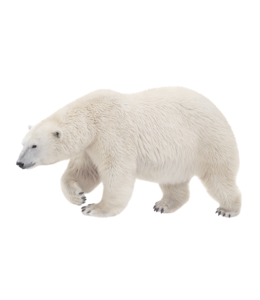
THE POLAR BEAR IS WELL ADAPTED TO LIVING IN THE ARCTIC ENVIRONMENT:
- The fur, made up of an outer layer of long guard hairs and a dense undercoat of short hairs, is oily and water-resistant. It has excellent insulation properties and keeps the bear warm.
- Black skin absorbs radiation heat from the sun.
- The long transparent guard hairs trap the sunlight and make the polar bear’s coat appear white.
- Subcutaneous fat layer (up to 11 cm thick) gives energy and provides buoyancy.
- Huge forepaws act as paddles when swimming.
- Hind feet push and serve as rudders.
- The soles are hairy and the black sole pads are covered with papillae, which prevent slipping on the ice.
- Webbing between the toes of the forepaws allows for effective swimming.
- Strong and up to 5 cm long sharp claws are used to gain traction on the ice, grip the prey and dig the den.
- The huge stomach is capable of digesting large amounts of energy-rich food.
- Slow moving (ca 4 km/h) guarantees energy saving.
- The elongated muzzle and neck help to warm the cold and arid inhaled air before it reaches the lung
- Small round ears minimize heat loss.
- Eyes are covered with a membrane, which shields them from bright sunlight.
- When diving, the polar bear’s nostrils close and it can stay underwater for up to three minutes.
